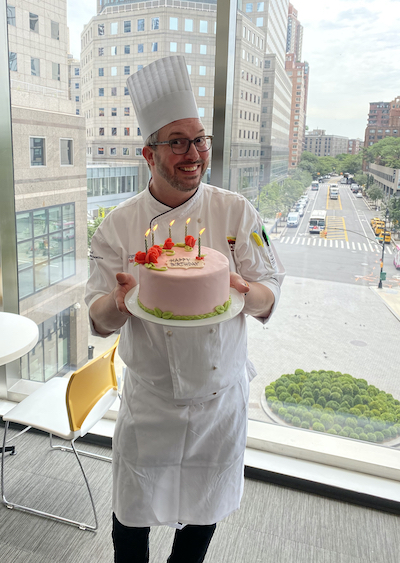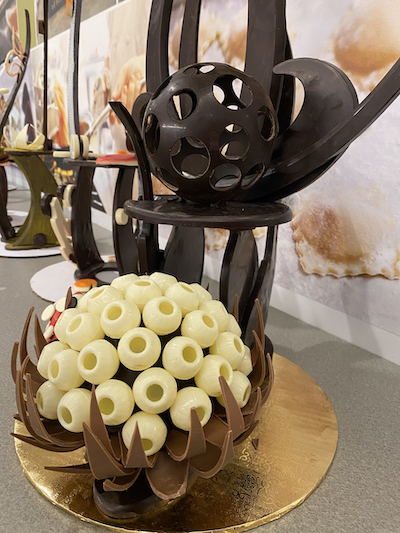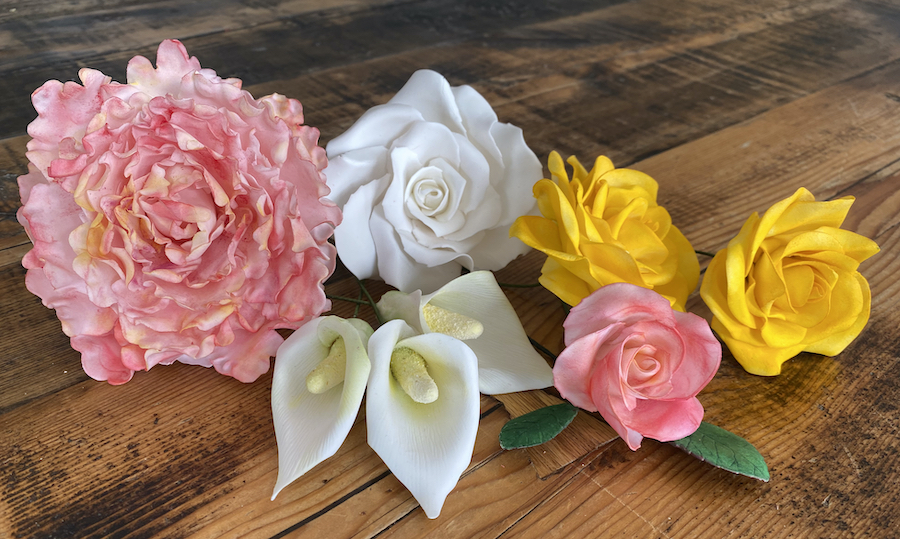Director of Pastry Research and Development Jürgen David shares a dozen ways he's working with flowers at the Institute of Culinary Education, from growing edible flowers in the hydroponic garden to shaping, hand painting and infusing in Pastry & Baking Arts.
Take a look around you right now. There are flowers everywhere: on phone cases, t-shirts, notebooks, water bottles, pencils. Maybe you have some on your desk or in your window. How about your food? Are there flowers there?
In pastry making, there are many ways we use flowers — often as a design element, but you can also hit the jackpot and create a food item with them.
At ICE there are many opportunities to not only use fresh flowers from our hydroponic garden, but we also introduce students to many different ways to create delicious blooms, blossoms and outstanding beauties. Let me take you for a tour through the world of edible flowers.
 Edible Roses
Edible Roses
Marzipan is made from almonds and sugar, a delicious paste that lends itself to shaping roses. I would consider this one a birthday-cake classic.
Here you take small rounds of marzipan, flatten them into petals (I use a firm bowl scraper) and bend them ever so gently to create the little buds, and then keep adding petals for a fuller rose. Give your roses some little green marzipan leaves, put the roses on a cake and I can already hear you sing “Happy Birthday!”
Modeling Chocolate Flowers
This type of modeling paste is made from melted chocolate and sugar syrup and does not dry as hard or solid as tempered chocolate, so shaping while pliable is key. It will eventually dry firm after a day or two.
Formed the same way as the marzipan rose, but with this you can create thinner edges on the petals. Timing is important as handling it too much will make the modeling chocolate too soft. If you wait too long, it will be hard and dull. Getting this right will make them nice and shiny.
Flower Sugar Cookies
Flood them with royal icing (confectioner’s sugar with egg whites), paint on them or use royal icing and the brush embroidery technique for this classic look.
I played around with this — baking cookies, outlining with royal icing and flooding the area with a thinner royal icing — quite a bit because it’s really fun, but patience is required to continue because the icing needs to dry between steps. I’ve painted flowers with undiluted gel food coloring before or used thick royal icing in a paper cornet (the pastry chef’s secret weapon) and a slightly wet brush to draw lines that mimic embroidery. I’ve also played around with adhering a patiently dried cutting and it is a picture of perfection, especially if you have lots of flowers to choose from, like I do.
Silicone Flower Molds
Simply pop the modeling paste of your choice in some adorable silicone molds and get immediate results!
Using fondant, marzipan or whatever paste you have on hand, simply press into the mold (I like to use a weighed amount for consistency and precision as well as speed) and unmold it right away. Flowers like these are ready in a flash. Try marbleizing or layering for different effects. To prevent sticking, a small amount of vegetable shortening or cornstarch can be dabbed into the mold. Less is more here. To create something really shiny, use a fancy luster dust. The only drawback here is that everything looks the same. However, cutting the molded pieces or trimming part of it can help get something unique.
![]()
Buttercream Flowers
With the flick of a wrist and the right piping tip these flowers made with decorator's buttercream can be conjured up in no time.
The right recipe and correct consistency for piping these are keys for me. Having little parchment squares on top of your flower “nail” is a neat way to work on one flower at a time, and it allows you to quickly move your masterpieces to safety.
There are so many different piping tips to use, so give them all a try. Play with the angle you use to hold the bag Also, do not fill your bag too much; not only is it heavy to hold, but your hands will melt the buttercream! (Warm buttercream will also have a plasticky, translucent look that I do not care for.) Keeping the piped flowers in the freezer makes it easy to place them on your cakes.
Tempered Chocolate Flowers
Shiny and delicate petals glued with great care and patience result in lookers like these.
 This flower will require more skill and a few nifty tools from the hardware store as well as knowing how to temper chocolate. One way to make the petals would be to spread a thin layer of tempered chocolate over a strip of acetate (plastic sheets make for shiny texture since it’s non-porous), wait for the cutting stage, cut triangles, bend chocolate-side-up into a mold and let set completely. Make a sphere for the center, attach the petals starting around the middle, adding more of them as you make new rows. I would describe attaching these in the way a pine cone has its scales. Flip it right-side-up and gently place it where it needs to go. This not only looks impressive but also — YUM!
This flower will require more skill and a few nifty tools from the hardware store as well as knowing how to temper chocolate. One way to make the petals would be to spread a thin layer of tempered chocolate over a strip of acetate (plastic sheets make for shiny texture since it’s non-porous), wait for the cutting stage, cut triangles, bend chocolate-side-up into a mold and let set completely. Make a sphere for the center, attach the petals starting around the middle, adding more of them as you make new rows. I would describe attaching these in the way a pine cone has its scales. Flip it right-side-up and gently place it where it needs to go. This not only looks impressive but also — YUM!
Flower Infusions
Fresh flowers or their respective parts — even when they are dried — can pump up your flavor immensely. Infuse them into cream or butter, add to bread or cookie doughs and harvest all that flavor.
Pressed Flowers
These take patience, careful picking, placement for pressing and time for drying, but the result is satisfying and glorious — a thing of beauty to behold.
I use paper towels around my blossoms to create this vintage effect. I found, however, that the paper towels I used made a difference in the outcome. Some of my paper towels left a ribbed texture on my precious flowers that absolutely would not do!
After gently arranging the flowers, I used my fattest and heaviest cookbooks (if you have a copy of “Larousse Gastronomique” handy...) for maximum pressure, then I set them aside for weeks. To have the flowers truly dry will take some time, and the humidity of a pesky New York City summer was not my friend for expediting this step. During my research, I even saw some pressed flower kits for use in a microwave oven, but the old-fashioned glamour of using books is more my style. Patience is a virtue, after all. If I can wait for the flowers to grow, I can wait for the flowers to dry.
Fresh Flowers for Decor on Plated Desserts
Don’t have time to dry or press them? Try picking some to decorate your cakes or dishes. It’s amazing how the petals, leaves or even the pollen can enhance both your presentation and the flavor!
There’s no waiting here! Get them while they're fresh and at their peak, and place where it pleases the eye!
For chocolate and sugar showpieces, I tried using freshly picked flowers as well as pressed ones. I tried to make them part of the cast design pieces, and I’m still trying to figure out some steps to achieve the look I’m going for. Making the flowers stay in place is a challenge. Hot sugar syrup makes them wilt and discolor. Stay tuned for more on that technique in a future blog post.
Sugar Paste Flowers
This skill requires the most patience. There is a rabbit hole of tools and gadgets to shop for — don’t buy it just because it’s shiny! With added vegetable gums, this sugar paste can create the most realistic-looking flowers. The gums in the recipe allow the paste to dry into a porcelain-like state (leaving them very fragile and affected by humidity). The steps range wildly for the flower you are trying to replicate, so I’ll let the pictures do the talking. Just know that waiting for the pieces to dry takes patience and planning.

How to Use Isomalt for Pulled Sugar Flowers
Growing Edible Flowers
Nothing beats growing your own flowers and the satisfaction of harvesting them yourself. I picked and planted the following new flowers with our farm manager, Caleb Raff:
Red Clover
These came up really quick. Have you ever tried the center ends of the blossom’s petals? Fresh clover nectar is divine. This flower did not need much babysitting — just don’t call them a weed!
Primrose
I chose these because they grew in my grandmother’s garden. This specific variety is in the edible flowers category. These grow very slowly and aren’t ready, but we are not sure if they’ve been grown hydroponically before. Because they are perennials, they might take longer than originally thought. Time will tell.
Chamomile
Elegant and classic, they grew pretty quickly. And wow, they are tall! They also have the tiniest seeds I’ve ever seen. (When planting in the farm only one seed goes in per pod and you have to use tweezers.) They need to be pruned a bit so they will keep flowering.
English Daisies
After some pH adjustments of the water and a new swath of real estate for our typically biennial beauties, they are on the path to perfection. I, for one, am looking forward to seeing them thrive. They are starting to come along now.
Pro Tips
A few things to keep in mind when working with edible flowers:
Not all flowers are edible. Make sure to check before using or eating a plant. Just because it’s pretty does not mean it’s safe. Introduce fresh flowers into your diet slowly as you would with any new food.
No pesticides! No chemicals! Know your source. Flowers growing next to the road would be a hard no.
Freshly Cut Flowers vs. Store Bought vs. Dried
Fresh is fresh. Other than wilting and oxidation, fresh flowers will have their full potential when it comes to flavor and looks. Fresh edible flowers at the store might already be a week old by the time you buy them (think about shipping alone). Dried flowers, like any dried food items, will have a great shelf life and are a sure way to have some on hand for when they are out of season. The flavor profiles will have changed, however (think about herbal teas), so taste them first to adjust your recipes.
Excited about flowers? Try using them in a dish or making a dish that’s shaped like one. Share your creations in the comments below or with us on social media @iceculinary. Schedule a tour of our New York City campus here in downtown Manhattan to check out our hydroponic garden in person! I know I will keep using flowers and finding fun and delicious things to do with them, as long as they keep growing.
Ganache Filling
Flavor, BABY! Use freshly picked flowers to infuse the cream portion of a bonbon ganache. This chamomile-infused filling was a hit.
Here is the recipe we created in class with my inaugural chamomile from the farm. Clearly, these are not shaped flowers, but a way to utilize the deliciousness of fresh flowers to make this luscious ganache. (I am not stopping you from finding a flower-shaped bonbon mold!)

Ingredients
- 135 grams heavy cream
- 10 chamomile flowers, fresh from the garden
- 1/4 scraped vanilla bean
- 30 grams invert sugar or honey
- 260 grams white chocolate, melted
- 30 grams unsalted butter, en pommade (softened)
Directions
- Place the cream, chamomile flowers (their petals and leaves only), vanilla bean and invert sugar in a saucepan. Heat to infuse, and let steep for five minutes.
- Strain the cream mixture and discard the chamomile and vanilla bean; reheat the cream (without boiling it) and add to the chocolate. Stir the mixture with a small whisk in small circles, working from the inside of the mass toward the outside until incorporated. The resulting ganache should have a smooth, pudding-like texture with a glossy shine. Take your time with this step.
- Allow the ganache to cool to 35 C (95 F). Stir in the butter.
- TASTE IT!!!
- For bonbons, deposit the ganache directly into the pre-cast molds with a pastry bag. Take care to not overfill. Allow a small space to provide a sealing base and allow the centers to set at room temperature before applying the tempered chocolate seal.
- Let the tempered chocolate set and contract completely before unmolding.
- Using a parchment-lined half sheet pan, carefully invert the mold to release the finished bonbons. This may require a slight tap, or, in some cases, the molds may require a brief chill in order to achieve full contraction and release.
Study Pastry & Baking Arts with Chef Jürgen and his flowers.


